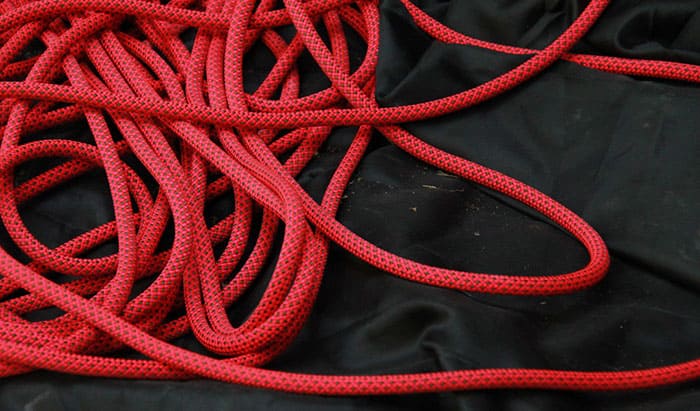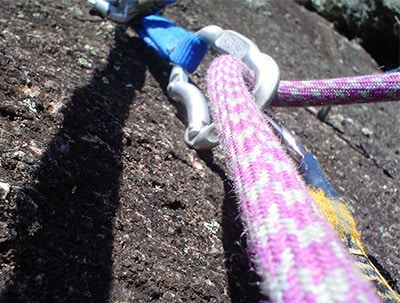When it comes to climbing, the rope is your lifeline. It’s the most important piece of equipment you need to have when climbing. Of course, the type of rope you choose depends on the type of climbing you are into.
For climbers, there are many types of rope, including the 16- and the 24-strand rope. But what is the difference between the two? After reading this article, you will know the difference between a 16 strand vs 24 strand climbing rope.
| Features | 16-Strand Rope | 24-Strand Rope |
| Usage | Double-Rope Technique | Double-Rope Technique Single-rope Technique |
| Construction | Main Core 16 Strand Polyester Cover | Main Braided Core 24 Strand Cover |
| Splice | Tight Eye Large Eye | Tight Eye |
| Stretch | More | Less |
Usage
When it comes to usage, the 16-strand rope and the 24-strand rope come with slightly different usage. The 16-strand rope is perfect for using the double-rope technique (DRT) since it is less static than its counterpart.
On the other hand, the 24-strand rope is known for its versatility and can be used for both the double-rope technique (DRT) and the stationary rope system (SRS), which is also known as the single-rope technique (SRT).
Construction
The way these two ropes are constructed is also different. The 16-strand rope features a core made of nylon and 16 strand polyester cover. The rope cover is where the overall strength comes from, while the main core works to retain the overall shape of the rope.
The advantage of having a 16-strand rope is allowing the user to quickly check on possible damage on the rope. When there is any cut or abrasion in any part of the rope, the rope owner can easily see the problem through the cover.
On the other hand, there is a reason why the 24-strand rope is called the rope within a rope. The double-braided rope comes with a braided core and a 24-strand polyester cover. When used, the cover and the core usually share the load, which fits the “rope within the rope” nickname.
With this type of construction, it is safe to say that this rope is stronger than the 16-strand type. This rope comes very smooth when used with a friction saver or ascender. This rope also works best when used with a pulley saver.
Splicing
Both of these ropes can be spliced but with a slight difference. You can hand-splice the 16-strand rope with a tight eye or a large eye. The tight eye is mainly used for carabiners as it sits snugly within the eye, which prevents cross-loading.
Meanwhile, the large eye can be strap hitched to the snap for a very quick on and off. When you splice a 16-strand rope, you will likely retain the rope’s strength compared to when you use a knot, as they don’t make tight bends on the rope.
On the other hand, the 24-strand double-braided rope can also be spliced with a tight eye. The tight eye can be used with a carabiner intended for the terminating end of a climbing system. Also, the cover of this rope can be quickly inspected for cuts or abrasion, but the core cannot be easily checked.
Stretch
A 16-strand rope is stretchy compared to the 24-strand rope. However, you will barely notice the stretch if you check it physically. The advantage of having some stretch on the rope is in situations of slipping off a limb or taking a fall in the rope.
When a rope has less stretch, the climber can easily feel the effect of the fall. Since it has a lesser stretch, the rope cannot absorb the energy which will be created in the stretch, which means your body will be absorbing the energy during the fall.
The 24-strand rope has less stretch, which makes them perfect when ascending. The rope is also perfect for single rope technique climbing together with a rope runner or even rope wrench. This rope allows mechanical devices to run smoothly along the length of the rope since the cover keeps the ascender from snagging.
Other Related Information
The strength of the 16-strand rope comes in its outer sheath. The core is there to make the rope maintain its shape or prevent it from flattening when the rope is used during the climb. With its 16 large strands, this rope provides a good grip which is perfect for climbers using body-thrusting climbing techniques. More importantly, using this rope prevents hand and arm fatigue when climbing.
On the other hand, the 24-strand climbing rope is known for its strength and stability. This rope is very tactile in the climber’s hands but comes with a little elongation and minimal bounce. Because of these features, this rope is perfect to be used in the single rope technique.
Conclusion
There are massive ropes to choose from when climbing, including the 16 strand vs 24 strand climbing rope. Comparing the two will let you know the different characteristics of this rope. Choosing between the ropes will depend on the type of climbing activity you do and the technique you are using.


